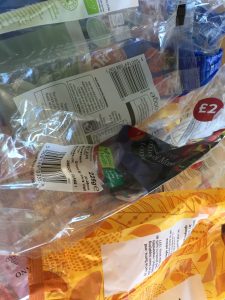 Over the last twelve months we have all been learning to react with horror to the ubiquity of throwaway plastics, those fabulously useful, flexible-yet-sturdy films, bags and containers that have become indispensable for their very dispensability. Plastic packaging panders to our desire for cleanliness (look, no mud!) and opens up all kinds of opportunities for branding, in full colour. Like the rind of a fruit, it offered itself up as a purely functional protective wrapping, to be thrown away without a second thought.
Over the last twelve months we have all been learning to react with horror to the ubiquity of throwaway plastics, those fabulously useful, flexible-yet-sturdy films, bags and containers that have become indispensable for their very dispensability. Plastic packaging panders to our desire for cleanliness (look, no mud!) and opens up all kinds of opportunities for branding, in full colour. Like the rind of a fruit, it offered itself up as a purely functional protective wrapping, to be thrown away without a second thought.
Now, though, the eight billion tonnes of plastic that we have released into the environment are coming back to haunt us. We have begun to understand that there is no biodegradability in the realm of plastics, which break into ever smaller pieces and eventually end up in the food chain. And nature photographers have pioneered a new genre of image, the depiction of animals and birds whose lives have been thwarted by plastic items floating across the world’s oceans. Such crossings of the beautiful with the mundane have done a lot to jolt us out of our torpor.
All of this made it interesting to come across the discussion of ‘transpapers’ in Rachel Bowlby’s Carried Away: The Invention of Modern Shopping (2000). This was the term given to transparent packaging, as it was developed in the early decades of the twentieth century. It was coined by the trade journal Shelf Appeal to get round the problem that Cellophane (a trademarked name) was starting to be used as a generic term for see-through packaging. Transpapers were the solution to many kinds of modern phobia–one version, Rayophane, was advertised as ‘Guaranteed Odourless, Hygienic, Dust-proof, Oil-proof, Grease-proof, Germ-proof’. But as Bowlby points out, they also gave the product a gloss and a sheen, a halo that signified ‘a kind of transubstantiation for the humble loaf of bread or bar of soap’.
The transpaper was a vital technical development facilitating the transition from old-fashioned shops (in which the shopkeeper brought products to the shopper) to new-fangled supermarkets (in which the shopper does the work). Now shoppers could touch the products without touching them, and the ‘cling-film culture of the modern supermarket’ was born. Bowlby quotes Georges Blond, a Frenchman visiting an American supermarket in the 1950s: ‘Cellophane is an obsession; after a moment you wonder if you aren’t yourself shut up in a transparent case’. Seventy years later, we are still wondering.
For details of the forthcoming CMT conference on paper, click here.